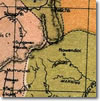
Pastoral Station entry
| Home | Browse | Search | Previous | Next |

|
Unlocking Regional Memory
Pastoral Station entry
|
|
Balaclava Station (1866 - ) |
||
|
||
| Location: Matheson, New South Wales, Australia | ||
Balaclava Station, first selected by John Ross in 1866, is situated about 20 kilometres west of Glen Innes in northern New South Wales. It was originally part of a vast property of 118,000 acres known as Waterloo (not to be confused with the property of the same name near Walcha), which had been taken up for Peter Macintyre by his agent, Alexander Campbell, around 1839. Several years after the Robertson Land Acts were passed (1861), Ross, an overseer at Broadmeadows, had discovered Waterloo’s rich pastures while searching for strayed stock. He was sufficiently impressed by what he found there to claim a block of 320 acres in accordance with the requirements of the free selection laws. He selected a further 320 acres in the name of his wife, and, keen to overcome the problem of tenancy, built a homestead which straddled both blocks of land. The property, like so many in New England, was primarily a sheep-carrying station, but Ross also became famous for breeding ponies and galloways on Balaclava. Later, under the auspices of his son, AF Ross, and grandson, CAM Ross, these pursuits were complemented by the development of a herd of Aberdeen Angus cattle. In contrast to the overwhelming majority of large properties on the New England tablelands, Balaclava Station actually increased in size during the nineteenth and twentieth centuries. From the original allotment of 640 acres, John Ross took up ‘dummy’ selections for each member of his family during the 1870s and 1880s. By the time it passed to his son, the property consisted of 3,600 acres, and under AF Ross, a further 3,700 acres were acquired, thus giving Balaclava Station its present area of 7,300 acres. Full Note:
|
| |
Related People | |
| Top of Page | |
|
|
| ||
|
Published by The Australian Science and Technology Heritage Centre, 5 April 2004 Prepared by: Acknowledgements Updated: 23 February 2010 http://www.nswera.net.au/biogs/UNE0042b.htm |